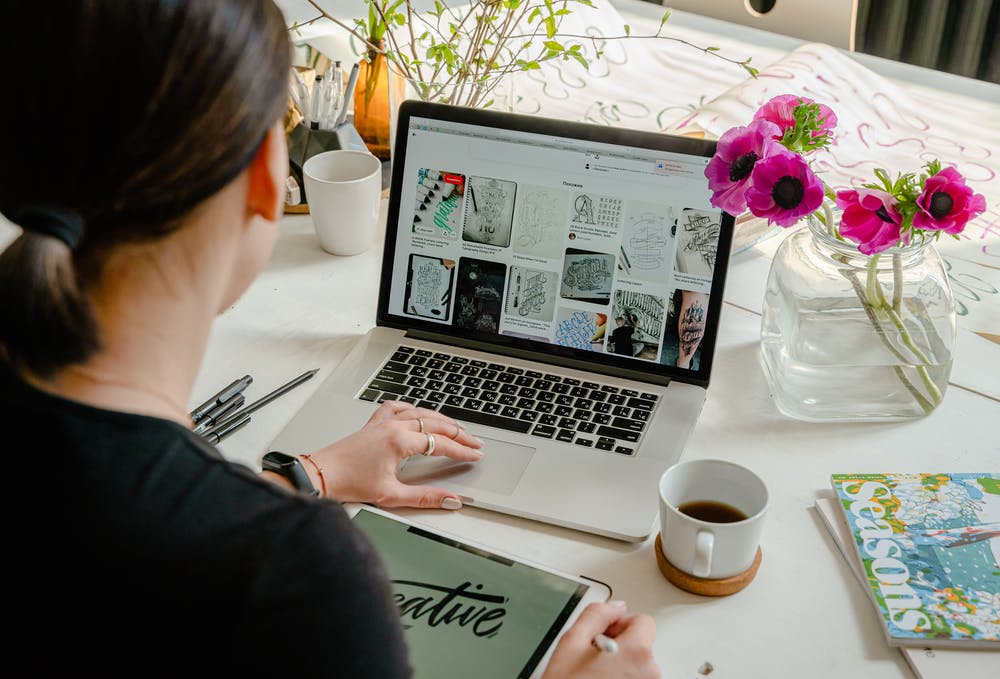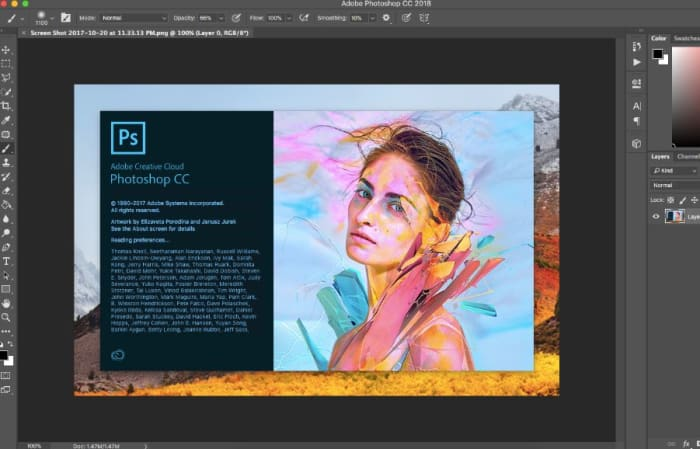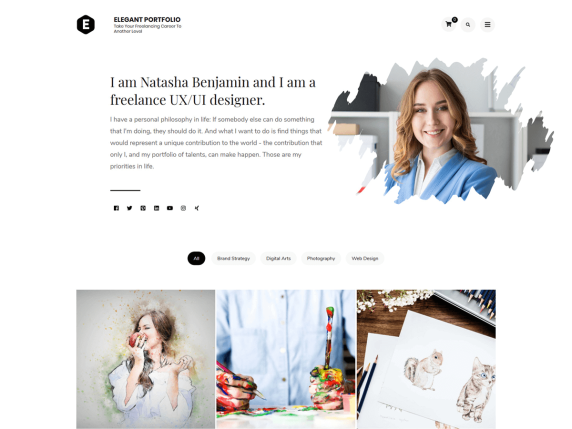
Working independently is an increasingly common choice for individuals pursuing creative careers.
Did you know that 90% of graphic designers are freelancers?
Freelancing gives you benefits such as control over your work-life schedule and being your own boss. Plus, you get to work on a number of projects for different clients and add variety to your portfolio.
Keep reading to discover what exactly freelance graphic designers do and how to get started on your journey today.
Page Contents
What is a Freelance Graphic Designer?
Graphic designers communicate ideas to customers using visual design and software. As a freelancer, you work for several clients instead of one employer. Freelance graphic designers work on projects like logos, web design, presentations, and UX design.
Full-time freelancers are considered self-employed and often work with a handful of clients at once. All types of businesses have visual design and branding needs, which means you can work with a wide variety of clients as a freelance graphic designer.
Freelance Graphic Designer Salary
On average, freelancers make more than traditionally employed graphic designers who earn $46,638 annually.
According to ZipRecruiter, most freelance graphic designers earn an annual income ranging from $44,500 to $65,000. The median salary of a freelance graphic designer in the U.S. is $55, 642 or $27 per hour.
As a freelance graphic designer, you get to set your hourly rates and work for several clients at one time.
Requirements to Become a Freelance Graphic Designer
As a freelancer, you don’t always need formal education. However, for graphic designers, a Bachelors Degree in Graphic Design or a related field (like Interactive Media or Advertising) can help you find more clients and charge higher rates.
You’ll also need to be proficient in Graphic Design software such as Adobe Suite (PhotoShop, Designer, InDesign). Knowledge of coding or programming can help if you’re interested in working in web design or UX design.
Types of Freelance Graphic Design Jobs
There are several types of projects, or jobs, you can work on as a freelance graphic designer. Here are some of the most popular.

Web Design
Web design projects involve using visual elements to communicate ideas on a website. You need to create design blueprints for individual web pages, and then you’ll often use web programming knowledge to turn your designs into a live website.
If you want to work on web design projects, you should have knowledge of WordPress website building or coding languages such as HTML and CSS.
As a web designer, you can also specialize in certain types of websites such as online stores where you need to craft visuals for product pages and the checkout flow.
Logo Creation
Designing logos is one of the most common types of freelance work graphic designers can find. Small businesses, startups, and existing brands all need logo creation or updating at some point.
Logos can cost as little as a few dollars or as much as a few thousand dollars depending on the creator’s experience level and quality of work. Today, logo designers need to come up with the brand’s logo and create that same logo in several file types that a brand can use on their website, social media, printed materials, and email communications.
If you specialize in logo creation, you need to have excellent InDesign or PhotoShop skills, but you don’t need website programming experience.
Brand Identity Creation
A brand designer works with clients to develop and implement the brand’s identity. In addition to logo creation, brand designers can choose color schemes, fonts, and help set rules for the tone of voice on all company publications. Clients may also need help implementing the brand style guide on their website, product packaging, email templates, or social media posts.

UX Design
UX design is short for user experience design. If you work in UX design, you’re responsible for designing apps, websites, and products that are easy for people to use.

In addition to visual design and communication skills, it’s helpful to have experience with user testing, information architecture, and prototyping if you want to venture into UX design projects. UX design tends to be a collaborative role where you advise the people creating and selling the products.
Skills You Need to Be a Freelance Graphic Designer
As you can see, there are various specialties to choose from under the graphic design umbrella. However, there’s a few skills common to all graphic design jobs that you should master as you progress on your journey.
Graphic Design Skills/Visual Design
First off, you need to have visual design skills. If you go the formal education route, you can get a degree in graphic design, interactive media, visual design, or even advertising. A visual design education includes classes such as typography, layout, information design, and packaging design.

You can also supplement your education with classes in photography, studio art, or animation. Ultimately, you need to be an expert on understanding how to use visual elements to effectively communicate information.
Web Design
Modern businesses need websites. It’s how they tell their stories, show off their brand identity, capture leads, and sell products. Website design is a crucial skill for graphic designers.

Knowing how to code and turn your designs into a live website is a plus. But, you’re not always responsible for building the website. At the very least, you should know how to create wireframes and detailed mockups for website pages and know how to map out a website experience.
Communication
As a graphic designer, visual communication is your bread and butter. However, working as a freelancer requires strong written and verbal communication skills.
Think about it.
You need to market yourself, pitch your services to clients, and keep them informed of project statuses along the way. Make sure you know how to communicate in meetings and via email so you can build trust and relationships with your clientele.
Project Management
There’s nothing quite like the freedom of being your own boss. However, working for yourself can overwhelm you if you have trouble managing your time.
When you work as a freelancer, you may have several projects going on at once. Investing in project management skills helps ensure that you deliver on time, keep your quality of work high, and accurately budget time and money for each client.
Taking the time to learn how to use project management software and stay disciplined will pay off in the long run as you grow your list of happy clients who are happy to recommend you to others.
How to Become a Freelance Graphic Designer
If the idea of working for yourself as a creative entrepreneur has you chomping at the bit, then you’re in the right place.
Here are the steps to follow to start your freelance graphic design career.
1. Select Your Niche
Freelancing can be a rewarding career, but it’s also a competitive field. The more specifically you craft your offering, the better you’ll be at pitching your services and getting clients.
Start by choosing the types of projects and services you plan to offer, and then narrow down your target client by:
- Industry
- Business size
- Business type (startup, agency, nonprofit)
- Business location
- Style/values
In other words, don’t go after the whole pie of possible clientele at once. Figure out a slice that matches your skill sets and gets you excited to get to work.
Remember, your niche can change as your progress. Start with what you’re good at now and where you have the most relevant skills and contacts, and then see where it takes you.
2. Build Your Portfolio
Once you know what services you’ll offer and who you want to work with, it’s time to build your portfolio. If you’ve been working as a graphic designer, art director, or creative director you can use past work projects for your portfolio.
Otherwise, if you’re building your portfolio from scratch choose projects and work samples that match your niche. You can also reach out to relevant nonprofits and offer to do pro bono work in exchange for a review of your services.
3. Create Your Freelance Website
Remember when we said almost all businesses need a website? That includes you too. Your website is where potential clients go to see if they want to work with you.
As a graphic designer, your website is also the perfect place to show off your visual communication skills and design personality.
Want to know more about where to start? Check out our article on everything your freelance website needs to attract clients.

Include your services offered and contact information, and don’t be afraid to let your personality shine. This is where potential clients will come to figure out if you’re the kind of person they want to hire.
4. Find Your First Client
Ah yes, the first client. You can start by scouring freelance websites such as Fiverr and bidding on gigs, but the competition can be high and the payoffs aren’t always the best.
Instead, try reaching out to your existing network. Do you have old professional connections or even friends and family that might introduce you to potential clients? We get it. It’s uncomfortable to sell yourself, but it pays off.
Remember, you’re a business now, and you should market yourself like one. If you don’t have anyone in your network you can contact, then make a list of small businesses or companies you want to work with and start building relationships.
If you find a potential client that’s got a problem you can solve, then ask for a pitch meeting get your freelancer proposal together and ask for the job. You’ll never know unless you make the ask.
5. Grow Your Business
After you complete your first couple of projects, you have some excellent tools to help you grow your book of business. Word of mouth is one of the best marketing strategies you can use as a freelancer.
Always ask for referrals, introductions, or reviews of your services. In addition to building your network, keep your website updated with some details about your projects and clients. The more work you have on your portfolio, the easier it is to build trust with someone who visits your website.
And, of course, continue learning and building your skillset. Make sure you stay one step ahead of your clients, and they’ll love you for it.
Putting it All Together: What is Freelance Graphic Design? And How to Get Started
Learning how to find clients and market yourself isn’t for everyone, but neither is a nine-to-five office job. If the idea of working for yourself, setting your own hours, and taking on a variety of projects excites you, then you should consider freelancing.
Almost all businesses have some need for graphic design support, whether they’re rebranding, building a website, or needing that perfect pitch deck. So, if you’re ready to dive in and bet on yourself, check out our comprehensive list of resources for creative entrepreneurs today.
And let us know in the comments, are you considering working as a freelance graphic designer? What’s motivating you and what’s getting in your way?
